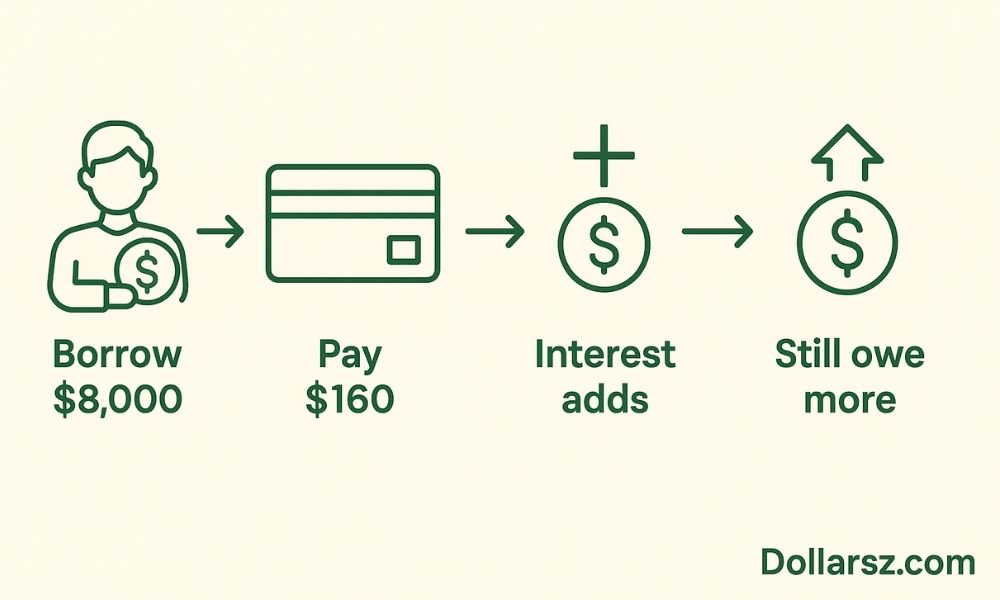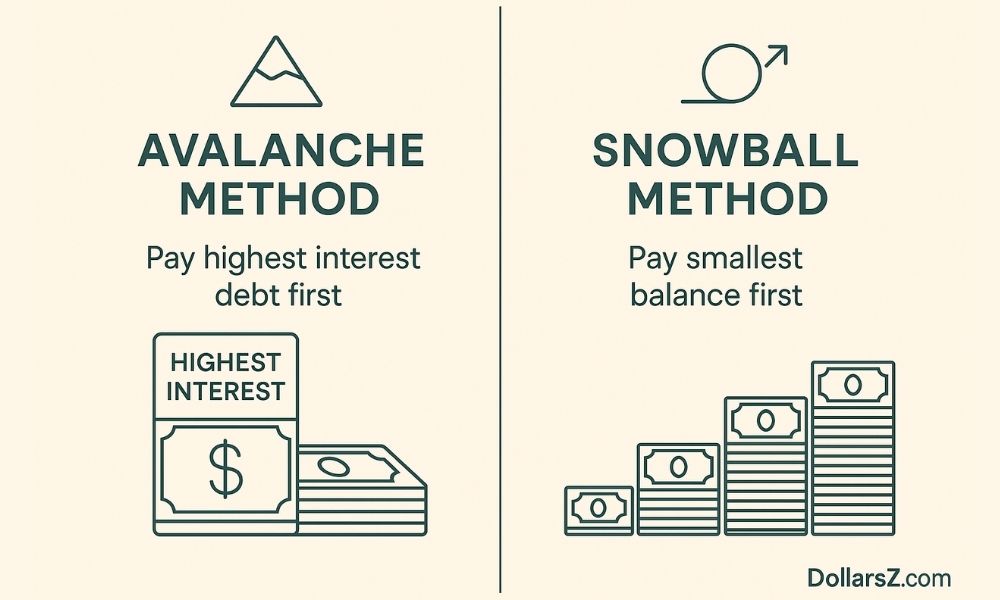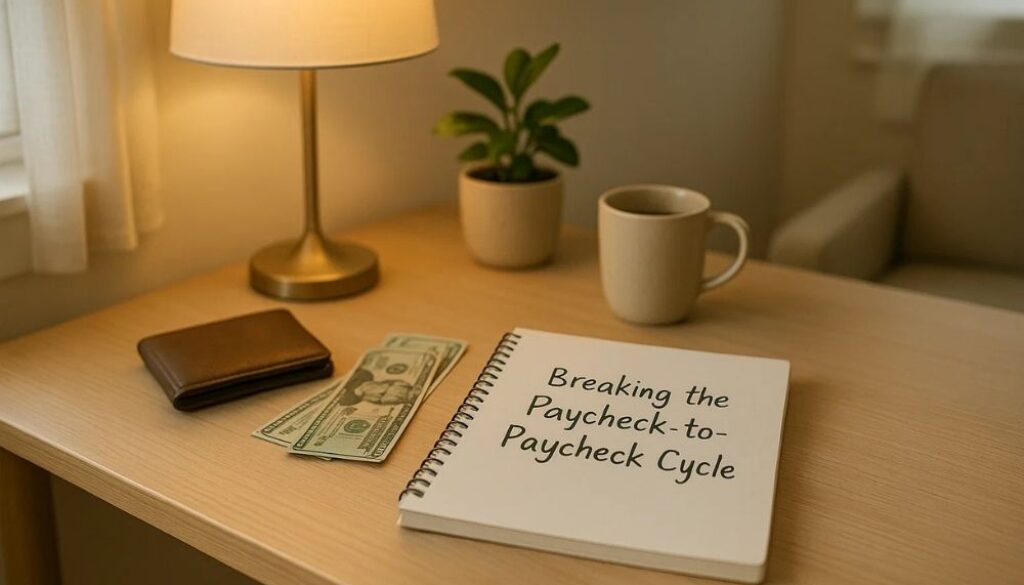10 Proven Ways to Break Free from the Paycheck-to-Paycheck Trap
In 2025, around 67% of Americans are living paycheck to paycheck, which is a 4% jump from last year, according to the PNC Bank Financial Wellness Report.
Inflation is one reason, but it’s not the only one. There are deeper habits, choices, and money systems that keep many people stuck in this cycle.
In this article, I’ll break down what’s really driving the paycheck-to-paycheck lifestyle and how you can start breaking free from it.
What Is a Paycheck-to-Paycheck Lifestyle?
A household is said to be living paycheck to paycheck when its monthly income just covers all the basic expenses like rent, groceries, and bills, leaving almost nothing at the end of the month.
But in reality, if your spending on necessities goes beyond 80% of your income, you’re already living that way. Because you can’t keep 10% aside for emergencies and another 10% for savings. One small unexpected expense can easily shake your whole budget.
How Small Money Habits Turn Into a Paycheck-to-Paycheck Life
There are two main factors that pull people into this lifestyle and keep them stuck in it. They are:
- Economic factors
- Psychological factors
Economic Factors: The Hidden Traps in the Economy
1.Wage Stagnation vs. Rising Costs
Wage stagnation:
Wage stagnation means the income of workers is not growing fast enough compared to inflation.
Even if the paychecks may look slightly bigger each year, when you compare them with inflation, the real purchasing power stays the same or even falls.
Rising costs:
Rising costs refer to a steady increase in the prices of everyday goods and services, including food, medicine, tuition fees, and housing.
When costs rise faster than wages, people’s purchasing power decreases. This situation is leading people to fall into a paycheck-to-paycheck lifestyle, or even worse, credit card debt.
Examine the table for a clearer understanding:

2.The Debt Spiral
A debt spiral occurs when a person’s debt increases faster than they can pay it off.
This usually happens because of high interest rates and repeated borrowing to cover everyday expenses.
Credit card debt is one of the clearest examples — where interest keeps building even when payments are made.
For better understanding, take a look at the example below.

My friend Lisa used her American Express Gold card to spend $8,000 on a bedroom makeover.
The card charges around 22% interest, and she has been paying only the minimum payment of $160 per month.
After one full year, she paid a total of $1,920.
But when we checked the numbers, we realized something shocking:
Out of that $1,920, only $177.16 actually went toward reducing the debt.
The remaining $1,742.84 was interest alone.
That means 90.8% of everything she paid went straight to the credit card company — and her balance barely moved.
This is how so many Americans fall into debt traps without even realizing it.
3.Income Volatility and Job Insecurity
10.7% of millennials say unstable employment is the main reason they live paycheck to paycheck.
When your income is not steady, it becomes extremely hard to plan your monthly life.
One month you work full hours, the next month your hours are cut, or the job itself is gone.
You start depending on credit cards just to fill basic needs because you don’t know how much you’ll earn next month.
Even if you work hard, the stress of “will I have income next month?” keeps you stuck in survival mode.
This is how income volatility slowly pushes people into debt — not because they are careless, but because their income is unpredictable.
4.Housing Costs Crushing Budgets
Almost 50% of renters in the U.S. are now considered cost-burdened, which means they are spending over 30% of their income just on housing.
When rent takes that much from your paycheck, there is very little left for food, utilities, savings or even small joys in life. It feels like you’re working only to pay for a place to sleep.
Housing has become more expensive over time too.
Years ago, housing made up about 33% of the average household income. Today, it takes around 51%. So the same paycheck now covers less home than it used to.
People are paying more while getting nothing extra in return.
And the situation keeps getting tighter. In just one year, median rent increased from $1,354 to $1,406. It may look like a small jump on paper, but when every single dollar already matters, that extra cost hurts.
This is why so many households feel like they are always behind. Not because they are irresponsible, but because housing is consuming the income that used to go toward living, not just surviving.
Psychological Factors: The Mental Money Trap
1.The Identity Trap Behind Spending
For many people, spending becomes part of who they are.
Buying things starts to feel like proof of success, confidence, or status.
If someone grew up with financial scarcity, that old feeling of “I need to get it before I lose it” can stay with them, even when their income grows.
And when life is stressful, our mental energy gets drained, so we make quick, emotional spending choices instead of thoughtful ones.
This is how money becomes less about what we actually need and more about how we want to feel.
2.Lifestyle Creep: The Silent Wealth Killer
40% of Americans earning over $100,000 still live paycheck to paycheck because of something called lifestyle creep.
When income increases, spending increases right along with it.
What used to feel like a luxury slowly starts to feel “normal.”
Upgraded apartments, daily lattes, premium subscriptions, better furniture, nicer vacations—these things start as treats, but soon we can’t imagine living without them.
That’s hedonic adaptation — the brain adjusts and quickly raises the standard of what “comfortable” looks like.
So each time the salary goes up, expenses quietly go up too.
And before we even notice, that extra income is gone. Nothing goes into savings. Nothing goes into building wealth.
So even with a higher salary, people end up in the same place as before.
Still stressed.
Still tight.
Still stuck.
3.Emotional Spending
Emotional spending occurs when we buy something to alleviate our emotions, rather than purchasing what we actually need.
It typically appears when we feel lonely, stressed, hurt, or mentally exhausted. The purchase gives a small mood lift, and over time, the brain starts to treat spending as a way to feel better.
And today, online shopping has made this even easier. You don’t have to go outside or think twice. With just a few taps, the order is placed. The comfort is instant.
We see this a lot with food delivery. A small argument happens, emotions rise, and one person orders food to make a point or to soothe themselves. In that moment, it feels like control. It feels like “I don’t need you.”
But the relief is temporary.
Once the emotion settles, what stays behind is regret, guilt, and another expense added to the month.
This is how emotional spending slowly drains money, little by little, without us even noticing.
4.The Scarcity Mindset and Mental Load
Money stress does not sit in a pocket. It stays in the mind. Studies show that people dealing with financial stress spend around 6 hours per week just thinking and worrying about it.
On the other hand, billionaires like Mark Zuckerberg wear the same clothes every day to reduce decision-making and protect their mental energy.
Constant worry about money lowers focus, patience, and clarity. This leads to decisions like overspending, delaying payments, or relying on credit cards to get through the moment.
People are not stuck because they are careless.
They are stuck because their mind is tired from carrying money stress every day.
Let’s see how to get out of this paycheck-to-paycheck cycle.
1.Face the Reality First
Before changing anything, first you need to identify where things are going wrong.
Start by tracking your last month’s transactions. Write down everything.
After that, divide your spending into necessities and desires.
Now see how much money went into desires that didn’t actually add value to your life.
Next, calculate your debt-to-income ratio to understand how much of your income is going toward debt.
Now comes the mindset shift.
Money is not your enemy. Money is a tool for freedom.
Don’t feel bad about past decisions. What’s done is done.
Your focus now is simple:
Get clarity on where your money is going and start reducing the unnecessary spending slowly.
Small changes are easier to maintain and make a big difference over time.
2.Create a Budget That Actually Works
Budgeting is one of the most important steps to get control over your money.
Most people know the 50/30/20 rule, but even with that, the number of people living paycheck to paycheck is not really decreasing.
That’s why I tried a different approach: the 50/20/10/10/10 rule.
- 50% for needs
- 20% for investing
- 10% for emergency fund
- 10% for savings
- 10% for entertainment or self-enjoyment
This method worked better for me because it protects your future while still allowing some space to live your life.
If your income is low or you are in debt, then your entertainment section should never go above 10%.
The goal is balance, not restriction.
3.Build an Emergency Fund (Even While in Debt)
Do you know what is going to happen in the next second?
None of us do. If we did, we wouldn’t be here reading or learning.
Life is unpredictable.
You might lose your job, fall sick, or face an emergency you never saw coming.
And in those moments, most people swipe a credit card or borrow money just to survive.
But what if the credit card maxes out?
What if no one is able to lend you money?
That’s why we build an emergency fund.
Aim for at least 6 months of your basic living expenses, so even if something happens, your life doesn’t collapse overnight.
Even if you are in debt, still try to save a small amount consistently.
$5, $10, $20 — whatever you can.
The amount is not the point.
The habit is.
Because an emergency fund protects you from:
- Swiping credit cards during crises
- Falling back into the same stress again and again
This is your safety net. It keeps you stable when life shakes you.
4.Tackle Debt With a Strategy
Choose a debt payoff method that fits your personality.

Avalanche Method:
Pay extra on the debt with the highest interest.
This saves the most money in the long run.
Snowball Method:
Pay off the smallest debt first.
This gives quick wins and keeps you motivated.
There is no “best” method.
The best one is the one you will stick to.
You can also try a few simple strategies while paying down debt:
- Call your lender and ask for a lower interest rate
- Use debt consolidation only if it actually reduces your total cost
- Pause credit card usage for a while
- Transfer high-interest debt to a lower-interest card if possible
Remember, progress is progress.
Even slow progress counts.
5.Cut Expenses Without Feeling Deprived
You don’t need to stop living your life to save money.
The goal is to remove the spending that is silently draining your wallet, not the things that genuinely bring you joy.
Start with the basics:
Check for subscriptions you don’t use, reduce eating out, avoid impulse app orders, and cancel paid upgrades you forgot you were even paying for.
Try using cash for small day-to-day spending.
When you can see the money leaving, your mind naturally becomes more careful.
It makes your spending more intentional.
This is not about cutting happiness.
It’s about cutting the waste.
6.Increase Your Income (Even a Little Helps)
It’s always good to earn a little extra.
In today’s internet world, there are so many side hustles you can do from home, on your own time.
You can try things like blogging, YouTube, selling on Etsy, affiliate marketing, and many more online income streams.
Pick something that feels comfortable and natural to you, so you can stay consistent.
If you stay consistent with any one of these, you can genuinely make good money over time.
And when your income increases, do not upgrade your lifestyle.
Keep your spending the same and save at least 50% of the extra income.
This is how you create breathing room and slowly move out of the paycheck-to-paycheck cycle.
These articles can help you make extra money:
21 low-cost home business ideas for moms(Start with $100 or Less)
iPhone Reselling Made Simple: Turn $300 into $1,000 in a Week
12 Legitimate Ways to Make Money Online Using AI (Beginner-Friendly)
YouTube Automation Made Simple: Earn from Home Without Showing Your Face in 2025
7.Guard Yourself From Lifestyle Creep
When your income increases, it is very tempting to spend more. But this is how people stay stuck, even when they are earning a high salary.
In fact, around 41% of people earning $300,000 to $500,000 a year, and 40% of those earning above $500,000, are still living paycheck to paycheck. Not because the money is low, but because the spending keeps rising with the income.
So keep your lifestyle the same for a while.
Before purchasing something, ask yourself: Is this a need or just a want?
Avoid increasing fixed expenses like rent or car payments after a raise.
When your income goes up, let your savings go up too.
Focus on quiet wealth, not looking wealthy.
8.Stay Supported
Changing your financial life becomes much easier when you don’t try to do everything alone. You don’t have to carry the stress by yourself.
You can join a credit union to get fair interest rates and simple financial guidance.
Use free budgeting apps to track your spending so you know where your money is going.
If you notice that your spending is emotional or stress-based, talk to someone you trust or a counselor to understand the pattern.
Pick a financial accountability partner — someone you can share your goals with and check in regularly to stay consistent.
And most importantly, celebrate your progress.
Even small wins matter.
They are proof that you are moving forward.
9.Reduce Financial Stress as You Go
Financial stress doesn’t just stay in the bank account. It affects the mind.
So while fixing your money, you also need to take care of your mental space.
Try simple things like:
- Getting regular sleep
- Doing light exercise or even a short walk
- Taking small breathing breaks
- Setting one calm time each week to look at your finances
And very important:
Do not make financial decisions when you are angry, emotional, or overwhelmed.
Give your mind space.
Decisions are clearer when you are calm.
10.Think Long-Term
Once your debt is under control and you have an emergency fund, start looking ahead.
Keep your lifestyle slightly below your income. This gives breathing room.
Continue saving consistently.
Start investing, even if it’s a small amount each month. The habit matters more than the number.
Focus on building your net worth, not just earning more money.
Net worth is what stays with you.
Over time, try to create more than one income source so you don’t depend on just one job.
The goal is not to get rich quickly.
The goal is to reach a point where money stress doesn’t control your life anymore.
Final Thoughts
Money problems won’t be solved overnight.
You need patience and consistent effort to fix them.
The first step is always awareness.
You have to see where the money is going, and then slowly cut the expenses that are not adding value to your life.
Many of us think that earning more will automatically make us financially free.
But the truth is, freedom comes when your spending stays lower than your income, no matter how much you earn.
And to make life more stable, work on building multiple income streams over time.
Having more than one source of money makes you stronger and more independent.
Small steps done consistently can change your entire financial future.
Stay patient. Stay focused.
You are building something better for yourself.



Escape the Middle Class in 2025: Why Most Are Falling Behind and How You Can Get Ahead - dollarsz.com
November 2, 2025 @ 5:37 am
[…] is structured in a way that keeps people living paycheck to paycheck. You can check my article “10 Proven Ways to Escape the Paycheck Lifestyle” to learn how to break out of […]